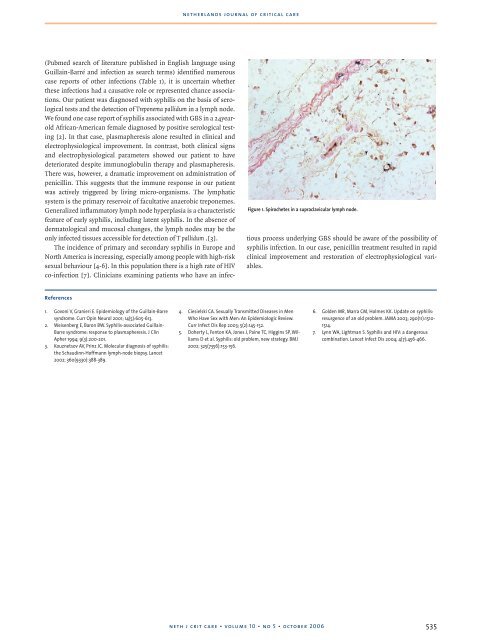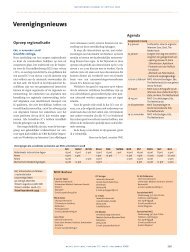Netherlands Journal
NJCC Volume 10, Oktober 2006
NJCC Volume 10, Oktober 2006
- No tags were found...
You also want an ePaper? Increase the reach of your titles
YUMPU automatically turns print PDFs into web optimized ePapers that Google loves.
netherlands journal of critical care<br />
Figure 1. Spirochetes in a supraclavicular lymph node.<br />
(Pubmed search of literature published in English language using<br />
Guillain-Barré and infection as search terms) identified numerous<br />
case reports of other infections (Table 1), it is uncertain whether<br />
these infections had a causative role or represented chance associations.<br />
Our patient was diagnosed with syphilis on the basis of serological<br />
tests and the detection of Treponema pallidum in a lymph node.<br />
We found one case report of syphilis associated with GBS in a 24yearold<br />
African-American female diagnosed by positive serological testing<br />
[2]. In that case, plasmapheresis alone resulted in clinical and<br />
electrophysiological improvement. In contrast, both clinical signs<br />
and electrophysiological parameters showed our patient to have<br />
deteriorated despite immunoglobulin therapy and plasmapheresis.<br />
There was, however, a dramatic improvement on administration of<br />
penicillin. This suggests that the immune response in our patient<br />
was actively triggered by living micro-organisms. The lymphatic<br />
system is the primary reservoir of facultative anaerobic treponemes.<br />
Generalized inflammatory lymph node hyperplasia is a characteristic<br />
feature of early syphilis, including latent syphilis. In the absence of<br />
dermatological and mucosal changes, the lymph nodes may be the<br />
only infected tissues accessible for detection of T pallidum .[3].<br />
The incidence of primary and secondary syphilis in Europe and<br />
North America is increasing, especially among people with high-risk<br />
sexual behaviour [4-6]. In this population there is a high rate of HIV<br />
co-infection [7]. Clinicians examining patients who have an infectious<br />
process underlying GBS should be aware of the possibility of<br />
syphilis infection. In our case, penicillin treatment resulted in rapid<br />
clinical improvement and restoration of electrophysiological variables.<br />
References<br />
1. Govoni V, Granieri E. Epidemiology of the Guillain-Barre<br />
syndrome. Curr Opin Neurol 2001; 14(5):605-613.<br />
2. Weisenberg E, Baron BW. Syphilis-associated Guillain-<br />
Barre syndrome: response to plasmapheresis. J Clin<br />
Apher 1994; 9(3):200-201.<br />
3. Kouznetsov AV, Prinz JC. Molecular diagnosis of syphilis:<br />
the Schaudinn-Hoffmann lymph-node biopsy. Lancet<br />
2002; 360(9330):388-389.<br />
4. Ciesielski CA. Sexually Transmitted Diseases in Men<br />
Who Have Sex with Men: An Epidemiologic Review.<br />
Curr Infect Dis Rep 2003; 5(2):145-152.<br />
5. Doherty L, Fenton KA, Jones J, Paine TC, Higgins SP, Williams<br />
D et al. Syphilis: old problem, new strategy. BMJ<br />
2002; 325(7356):153-156.<br />
6. Golden MR, Marra CM, Holmes KK. Update on syphilis:<br />
resurgence of an old problem. JAMA 2003; 290(11):1510-<br />
1514.<br />
7. Lynn WA, Lightman S. Syphilis and HIV: a dangerous<br />
combination. Lancet Infect Dis 2004; 4(7):456-466.<br />
neth j crit care • volume 10 • no 5 • october 2006<br />
535







